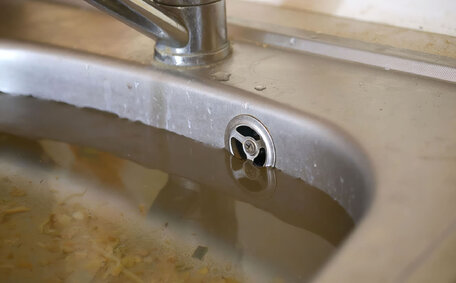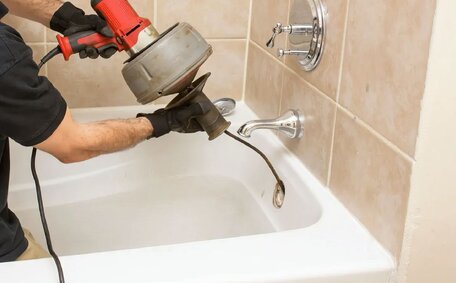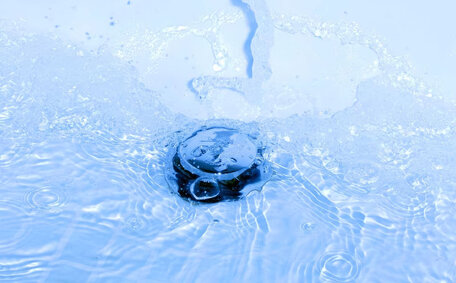Assessing the Drainage Problem
Start by examining your shower drain closely for visible clogs. Remove the drain plug and check for noticeable obstructions.
Remove obstructions such as hair and soap scum using rubber gloves or a wire hanger. Remove debris like hair, soap residue, or dead skin to alleviate clogs.
It’s also paramount to comprehend the possible causes that could be triggering repeated clogs in your shower, particularly when using drain cleaning methods.
Check if water pools near the drain rather than flowing freely, which may indicate a blockage. This indicates a shower drain blockage that a drain can experience that may require a professional plumber’s expertise to address fully.
Trying Quick Home Fixes First
Before seeking professional help, try some DIY techniques to unclog the shower drain yourself.
Use a Plunger
Plunging sends water down the drain to displace hair, soap, and other debris. Add a little water to the shower floor, seal overflow holes with a damp cloth, and apply firm plunges over the drain.
Baking Soda and Vinegar
Start by pouring half a cup of baking soda down the drain, followed by an equal amount of vinegar for an effective reaction. The exothermic reaction can break down the blockage, especially when followed by ½ cup of white vinegar. Allow the ingredients to mingle for a few minutes, particularly 10-15, then follow up with a hot water rinse.
Boiling Water
Boiling water is effective at dissolving soap and grease build-up that can clog pipes. Gently pour into the drain, allowing it to penetrate the buildup, which could cause blocked shower passages, then rinse with cool water.
Everyday household items can be a cost-effective first step in drain cleansing. If these DIY methods don’t resolve your blocked drain, don’t hesitate to contact a professional plumber to thoroughly clear the blockage.
Using a Plunger
For minor obstructions, a standard cup plunger can be very helpful. Begin by filling the shower basin halfway with water, which will help dislodge hair and soap buildup, preparing your drain for unclogging. Place the plunger directly over the drain opening, make sure it forms an airtight seal on all edges to unclog your shower with optimum force.
Hold the plunger handle against your midsection for effective leverage as you work to clear blockages from your shower drain. Agitate the plunger briskly up and down around 10-15 times – there’s no necessity to exert overmuch force – as this action can displace common culprits like hair shower blockages and encourage water through the pipes. Add a bit more water if needed to keep the drain submerged.
Avoid applying excessive force to prevent pipe damage. If plunging doesn’t clear blockages after several attempts, consider progressing to a drain auger or chemical drain cleaner.
Pouring Boiling Water Down the Drain
Pouring boiling water down the shower drain can clear minor soap and grease blockages.
Boil a kettle of water, then carefully pour hot water into the drain bit by bit, to help dissolve blockages. The elevated temperature of the water will assist in liquifying and could cause blocked residue to disperse soap scum, which you can then pour down the pipes.
Exercise caution when pouring, standing away from the steam and splash. Follow up by running hot water down the drain to help flush away any remaining residue.
Repeat the process as required, helping you to learn how to effectively sweep away any clog. Exercise caution with boiling water as overuse may damage your pipes over time. Should the blockage persist, it may be time to call a plumber to professionally alleviate your blocked shower scenario.
Making a Baking Soda and Vinegar Solution
A homemade baking soda and vinegar solution can quickly tackle drain blockages with its fizzing action.
To create that foaming mix with distilled white vinegar and baking soda:
- Start by removing the drain cover to make sure the drain opening is clear.
- Pour approximately 1 cup of baking soda into the drain.
- After the baking soda, add 1 cup of distilled white vinegar to enhance the cleaning power. Vinegar with higher acetic acid content works best.
- The mixture will forthwith froth and fizz, compelling the combination to actively infiltrate and let sit, coaxing your blockage to relent.
- Let the mixture sit for 10-15 minutes. The emitted gas diligently works to tease out clog components such as hair, facilitating their journey down the drain.
- Flush the drain thoroughly with hot water for a minute to let the residue drain away.
For ongoing issues, it may be beneficial to repeat the baking soda and vinegar treatment biweekly until the drain is clear. The bubbling reaction helps break down hair, soap, and other debris in your pipes.
Employing Mechanical Unblocking Methods
If home remedies fail, consider mechanical methods for unclogging your shower. Some useful tools are:
Wire Hanger
Straighten a metal wire hanger and gently guide it into the drain. Rotate and maneuver to snag and remove hair and debris, along with any sludge.
Drain Augers/Snakes
Use a drain auger or a plumbing snake to dislodge clogs in the shower drain. Use the tool to grip the blockage firmly and carefully extract it, thus clearing the clog. Be careful to avoid scratching your drain pipes.
For deep blockages beyond arm’s reach, rent or purchase a power auger with an extended steel coil to clear drains up to 3 metres deep.
If you’re using a drain auger, protect yourself with goggles and gloves to prevent injuries from splatter.
If home attempts fail, contact a professional plumber who uses industrial-powered drain augers.
Using a Wire Hanger or Hook
A straightened wire hanger can be manoeuvred to hook and dislodge debris clogging a shower drain. Carefully straighten a coat hanger, leaving a hook on one end. Insert it into the drain and gently twist, scraping the pipe walls as you go.
Carefully remove the hanger to extract the debris.
For drains with an overflow plate, angle the hanger underneath at 45 degrees to hook below the cover. Consider wearing gloves to protect against dirty water backsplash during removal. Work patiently with the improvised hook to clear out as much gunk as possible before trying other methods if needed.
Trying a Drain Snake/Auger
A drain snake, also called an auger, can be used to clear blockages deeper in your pipes that are out of reach. Introduce a few inches of the metal coil into the shower drain and gently twist the handle to unclog shower drain issues.
You can use the snake to advance deeper while the twisting motion works to address your clogged drain concerns by snagging hair and debris. Once the blockage is reached (indicated by resistance), continue turning the handle while maintaining pressure and pushing further down your shower drain.
Next, twist anticlockwise while gently pulling upwards to expel drain materials, then continue the operation to disengage the impediment. Drain snakes are available in various lengths from 15-30 feet, enabling access to tricky spots a wire hanger cannot.
Take safety precautions: wear gloves to grip tightly and goggles to avoid splatter exposure. Be patient working the snake to carefully clear clogs without scratching pipes. Consider trying a chemical drain cleaner if augering fails to open drainage.
Preventing Future Blockages
Install a hair catcher over the drain to collect hair and prevent clogged showers. Mesh or dome-shaped designs sit within the drain plate to catch loose strands while allowing water to clean your pipes.
Maintain regular cleaning by pouring baking soda and then vinegar down the drain monthly to dissolve grime, followed by hot water to rinse away any residue. Consider a monthly application of enzyme drain cleaner to keep your drains clean.
Inspect pipes underneath the house for root intrusion or cracks that allow dirt to enter, which can cause blockages. Monitoring water pressure can help detect clogs in development.
Though convenient for minor clogs, sidestep over-relying on harsh commercial drain openers as they can erode pipes. Consider plumbers servicing; industry-grade augers for drain unblocking protect pipes when agitating obstructions.
Knowing When to Call a Professional
If you’ve tried several home remedies and mechanical methods without success, it might be time to get in touch with us at Hornsby Plumbing for assistance. Persistent standing water signifies a more severe intrinsic blockage that may compel you to get in touch with us for specialised service.
Hornsby Plumbing’s licenced technicians have industry-grade augers that can clear blocked and even the most stubborn obstructions a shower drain can have up to 50 metres down the pipe without risk of damage. We also utilise advanced camera technology to inspect your pipes and precisely locate the clog.
For effective solutions for clogged shower drains drain issues, simply call us at Hornsby Plumbing. We are available 24/7 to address blocked drains and can provide solutions to prevent future clogs.






